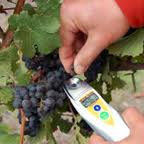 |
| Harvest Moon |
Gathering
the grapes under a harvest moon is a romantic image, but it also has its
roots in an age-old tradition.
Europe, Chile, and Argentina all harvest at night. In the U.S., California, our largest grape producing state,
harvests about two-thirds of its grape crop after the sun goes down.
 Harvesting grapes at night allows the picking to occur when the temperatures are
cooler. This is a benefit for
workers, but it is also when the sugar levels in the grapes are more stable,
the quality and acid levels are better, and there is less chance of spoilage.
Plus, more tonnage can be picked and processed at night.
Harvesting grapes at night allows the picking to occur when the temperatures are
cooler. This is a benefit for
workers, but it is also when the sugar levels in the grapes are more stable,
the quality and acid levels are better, and there is less chance of spoilage.
Plus, more tonnage can be picked and processed at night.Nighttime harvesting is also more energy efficient. Picking grapes when they have cooled in the darkness cuts down on the time and energy needed to pre-cool them before they can be pressed or fermented.
 When
grapes arrive at the winery in the early morning hours, they can immediately be crushed,
pressed, and the first fermentation started. When harvesting during
the heat of the day, grape temperatures can get up to 110 degrees. To crush and ferment they should be in
the 55-degree range, which means they must be chilled. Cooler grapes
also means the winemaker has better control of the first fermentation process.
When
grapes arrive at the winery in the early morning hours, they can immediately be crushed,
pressed, and the first fermentation started. When harvesting during
the heat of the day, grape temperatures can get up to 110 degrees. To crush and ferment they should be in
the 55-degree range, which means they must be chilled. Cooler grapes
also means the winemaker has better control of the first fermentation process. When harvesting begins at dawn, it is usually stopped by noon or 1 P.M. The temperatures in the vineyards are just
too hot for the workers, and the grapes.
When harvesting at night, workers can pick any where from 8 to 12 hours.
When harvesting begins at dawn, it is usually stopped by noon or 1 P.M. The temperatures in the vineyards are just
too hot for the workers, and the grapes.
When harvesting at night, workers can pick any where from 8 to 12 hours. And
the benefits for the workers are great. Nighttime temperatures are much easier to work in than the
hot 80 to 100 degree days during August and September. Workers don't have to
worry about bee stings and surprise snake encounters among the nighttime vines.
The only disadvantage to nighttime harvesting could be hilly or rough terrain,
which is more difficult to navigate at night.
And
the benefits for the workers are great. Nighttime temperatures are much easier to work in than the
hot 80 to 100 degree days during August and September. Workers don't have to
worry about bee stings and surprise snake encounters among the nighttime vines.
The only disadvantage to nighttime harvesting could be hilly or rough terrain,
which is more difficult to navigate at night.Night harvesting began in the U.S. in the early 1970’s. California and New York understood the benefits of harvesting at night and blazed the trail. Now, night harvesting is a common practice throughout the world. While mechanical harvesting is common at night, it takes a bit more prep work when the grapes are handpicked.
 Workers
may harvest under rented diesel-powered lights that road crews use for
nighttime work. Smaller vineyards
may simply give each worker a headlamp.
Regardless of the lighting method used, the grapes and the workers
are all fresher in the end.
Workers
may harvest under rented diesel-powered lights that road crews use for
nighttime work. Smaller vineyards
may simply give each worker a headlamp.
Regardless of the lighting method used, the grapes and the workers
are all fresher in the end. While
I’ve done my share of daytime grape harvesting, I have yet to take part in a
nighttime harvest. Something I'll add to
my bucket list ; )
While
I’ve done my share of daytime grape harvesting, I have yet to take part in a
nighttime harvest. Something I'll add to
my bucket list ; )
~ Joy










































